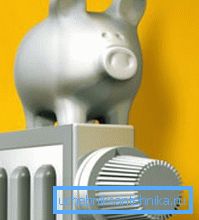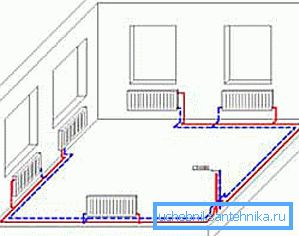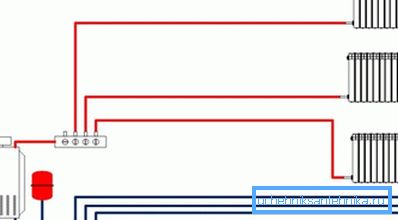Heating schemes for a one-story house: 3 efficient ways to
How to equip the heating of a private single-story home the most cheap and efficient? Which scheme is more effective: with natural circulation or forced? Answers to these questions, as well as recommendations for designing a climate system with your own hands, can be found in the material below.

Features of the heating system
Not only the comfort of the people living in it, but also its economy depends on what kind of heating scheme of a one-story house will be used to heat it. This is especially true in modern conditions, when the cost of energy used is constantly increasing.
When choosing a decision, you need to consider the following factors:
- Simplicity. It is desirable that there was an opportunity to mount the heating of a single-story private house with their own hands. This will minimize the cost of its arrangement.
- Economical operation. As already mentioned, the amount that will be spent every month for utilities depends on which technologies will be used. In this sense, the schemes of water heating of a single-storey house using a gas boiler operating on the trunk or liquefied gas are most effective.

- Reliability. Regardless of the ambient temperature and other external factors, the climate system of the home should provide comfort and coziness on the premises. Heating of a single-storey house should function so as to prevent the coolant from freezing even in the most severe winters.
- Autonomy. It is advisable to give preference to schemes that are least dependent on the functioning of external engineering networks. Otherwise, interruptions in the supply of gas or electricity, which often occur in the domestic realities, will cause a breakdown.
Tip! In this case, projects of one-story houses with stove heating are most acceptable. But in this case you will need to take care of the availability of a sufficient amount of solid fuel. In addition, the operation of the furnace requires constant attention to it from the person. Take this into account when choosing.
The choice of energy
The main element of any heating system is the boiler - a device that performs heating of the coolant, which then enters the radiators and heats the air in the room.
The following fuels can be used for heating:
- firewood - this option is especially effective if you can prepare it yourself, otherwise the cost of heating can be quite high;

- pellets and coal are a good option, but boilers operating on these types of fuel require constant attention from the person during operation;
- diesel fuel, electricity and liquefied gas are very efficient energy carriers, but their cost is quite high (they can be used when there is no gas line connection to the house);
- Natural gas is the most efficient and inexpensive way to heat a room.

Pipe routing
The scheme of the heating system of a one-story house, in addition to heating equipment and radiators, requires the presence of pipes, which are used to transport the coolant from the boiler to the heating panels.
In total there are three common schemes, each of which will be described in detail below.
Method 1. With one pipe
The most simple, effective and frequently used method of installation.
The scheme of a one-pipe heating system for a one-story house is constructed as follows:
- Along the perimeter of the walls of the house is installed trunk pipe with a diameter of at least 32 mm. It must be mounted at an angle so that the cooling coolant will automatically return to the boiler under the action of gravity for subsequent heating. (See also Pipe Layout: Features.)

Tip! Some “experts” advise installing a pipe outside the home, citing aesthetic reasons. You do not need to do this! Since such a solution leads to significant heat loss, reducing heating efficiency.
- To the resulting ring using pipes of smaller diameter (20 mm) dock heating panels. It is desirable to connect them through valves with thermostats. So you will be able to regulate the temperature of each radiator separately. In the upper part of the heating panel, it is necessary to provide for the installation of an air valve, which will prevent the air system from “overflowing”, which negatively affects the operating efficiency of the heating system.

This scheme of home heating has many positive points:
- its installation does not cause difficulties even for inexperienced craftsmen;
- to install such a scheme, you need to purchase the minimum possible number of pipes and other parts;
- all heat energy is consumed only indoors, its unproductive losses are excluded;
- If you use a heating scheme with forced circulation - a one-story house or a city apartment - this solution will allow the system to remain operational even in the case of a short power outage.
Method 2. With two pipes
In this case, as the name implies, one pipe is used to supply hot water, and another pipe is used to transport it to the boiler.
The scheme of the two-pipe heating system of a one-story house is mounted in this order:
- Two parallel pipes are stretched across the house - they can be installed in an open way, hidden under the floor covering, walled into the wall or decorated with a box;
- heating radiators and other similar equipment as if "crashed" into the pipelines, creating jumpers.

Hot water will more efficiently heat those rooms whose heating panels are located closer to the boiler. To balance the circuit, shut-off valves are often used, controlled manually or using thermostats.
The disadvantages of this solution are obvious:
- increased consumption of parts required for the installation of heating;
- danger of failure of individual network segments as a result of coolant freezing (this often happens if you open the valves that restrict the access of water to the radiators closest to the boiler).
Method 3. Radiation
It is very effective in terms of adjusting the temperature in individual rooms, but it is the most expensive and difficult to install. Such a scheme is more often used to provide heat for large areas of residential buildings where forced circulation of water in the pipeline is provided.
Installation instructions are as follows:
- Two collectors are installed in the boiler room or other suitable place, connected to the pipes supplying and discharging the coolant;
- from these collectors goes a pair of pipes to each radiator in the house.

The advantages of this system have already been mentioned, and as for the shortcomings, they are obvious:
- for installation, you must purchase a large number of parts and other equipment;
- it is necessary to solve the problem of where to hide the incoming and outgoing pipelines.
Conclusion
The efficiency of the heating system depends not only on the chosen scheme of its arrangement. It is also necessary to take care of high-quality insulation of the structure, as well as the installation of energy-saving windows. More information you can find out by reading the video in this article.